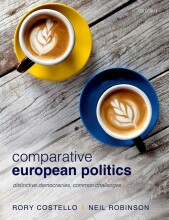Summary: Comparative European Politics Distinctive Democracies, Common Challenges | 9780198811404 | Rory Costello
- This + 400k other summaries
- A unique study and practice tool
- Never study anything twice again
- Get the grades you hope for
- 100% sure, 100% understanding
Read the summary and the most important questions on Comparative European Politics Distinctive Democracies, Common Challenges | 9780198811404 | Rory Costello
-
0 Introduction
-
0.3.1 Distinctive democracies
This is a preview. There are 2 more flashcards available for chapter 0.3.1
Show more cards here -
What is the difference between majoritarian and consensual-style democracies according to Lijphart (2012)?
Majoritarian democracies are characterized by a concentration of power and a confrontational relationship between government and opposition, while consensual democracies are characterized by the dispersal of political power among multiple parties and political institutions, and politics is a process of negotiation and compromise between them -
What is the meaning of a liberal democracy that most European countries are?
The power of the government is constrained by constitutional rules which are upheld by an independent judicial system -
What are, next to liberal democracy, characteristics of European countries?
A strong welfare state and multiparty competition -
0.3.2 Common challenges
-
What is the meaning of a 'party cartel' according to Katz and Mair (1995)?
Genuine competition between opposing parties was replaced with consensus and cooperation among the main parties and the silencing of opposing viewpoints -
0.4 Why compare?
-
What is comparative politics?
A field of study that is primarily focused on explaining differences and similarities between countries -
What is the scope of the 'most similar systems' design?
The 'most similar systems' design means that the researcher compares countries that are similar in many respects, but differ with regards to the causal factor under investigation. -
What does the 'most different systems' design mean?
Cases that are very different in many respects but share some common outcomes are studied -
1 Electoral systems
-
1.1 Introduction
This is a preview. There are 1 more flashcards available for chapter 1.1
Show more cards here -
What are the key dimensions of electoral systems according to Farrell 2011?
The electoral formula (how votes are translated into seats)
Districts and district magnitude (the division of a country in districts and how many seats per district)
Ballot structure (the nature of the choice and how votes are cast) -
What is the personalized effect on electoral systems?
Voters have more to say than they used to over not just how many seats each party wins but also which individual candidates fill these seats -
1.2 Electoral formula
This is a preview. There are 9 more flashcards available for chapter 1.2
Show more cards here -
What is an electoral formula?
The mechanism through which votes are counted and then translated into seats
- Higher grades + faster learning
- Never study anything twice
- 100% sure, 100% understanding
Topics related to Summary: Comparative European Politics Distinctive Democracies, Common Challenges
-
Electoral systems - Electoral formula
-
Electoral systems - Ballot structure and the intraparty dimension of electoral systems
-
Electoral systems - The main consequences of electoral systems
-
Political parties - Parties and democracy
-
Political parties - Social cleavages shaping party systems and party 'families
-
Political parties - How political parties transformed over time
-
Political parties - Changes in European cleavage structure and party landscapes
-
Voting behaviour - Sociological models of voting
-
Voting behaviour - Rationalist models of voting - The spatial model
-
Voting behaviour - Rationalist models of voting - Performance voting
-
Voting behaviour - Political change?
-
Political participation - Voting and protesting in Europe
-
Political participation - Theories of political participation - Individual-level ('micro') determinants of participation
-
Democracy and the EU - Democratic deficit? - Input legitimacy
-
Democracy and the EU - Representation through national institutions
-
The Executive Branch
-
Parties in Government
-
Parliaments - Fundamental design - Cameral structure
-
Parliaments - Roles and functions - Government formation
-
Parliaments - Strong parties, weak parliaments
-
Levels of government - Arguments for decentralization
-
Levels of government - Variations on territorial government
-
Politics and markets - Varieties of capitalism
-
Politics and markets - European political economy and the global financial crisis
-
The Rise of Anti-Establishment Parties

































